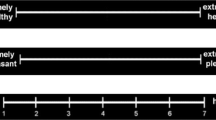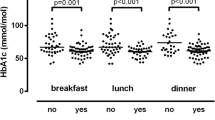Abstract
Aim: Central serotoninergic activity may modulate glucose metabolism via neuroendocrine effectors. Group Care is a clinico-pedagogic intervention that improves metabolic control and quality of life in Type 2 diabetes through lifestyle modification and, possibly, central mechanisms. The hypothesis that central serotoninergic activity is modified in patients followed by Group Care was tested by measuring their hypothalamic-pituitary-adrenal response to citalopram, a selective serotonin reuptake inhibitor. Methods and subjects: Ten healthy controls and 17 non-obese, non-insulin-treated patients with Type 2 diabetes received, in random order, iv infusions of either 20 mg citalopram or saline. Nine patients had been long-term on Group Care and 8 had always been on traditional one-to-one care. Circulating glucose, insulin, ACTH, cortisol, DHEA, GH and PRL were measured every 15 min for 240 min. Differences between areas under the curves after citalopram and saline (Δ-AUC) were calculated. Results: Citalopram stimulated ACTH and cortisol secretion in healthy subjects (p=0.026 and p=0.011, respectively) and patients on Group Care (p=0.056 and p=0.038) but not in patients on traditional care. In healthy subjects, basal glucose correlated with growth hormone Δ- AUC (r=0.820; p=0.004) and inversely with insulin Δ-AUC (r=−0.822; p=0.003). The former correlation was preserved in the patients (r=0.637; p=0.026). Conclusions: Diabetes may blunt the response of the hypothalamic-pituitary-adrenal axis to citalopram, but this is preserved in patients followed by a long-term intervention model that improves clinical as well as cognitive and emotional variables.
Similar content being viewed by others
References
Leibowitz SF, Alexander JT. Hypothalamic serotonin in control of eating behavior, meal size, and body weight. Biol Psychiatry 1998, 44: 851–64.
Lucki I. The spectrum of behaviors influenced by serotonin. Biol Psychiatry 1998, 44: 151–62.
Lam DD, Heisler LK. Serotonin and energy balance: molecular mechanisms and implications for type 2 diabetes. Expert Rev Mol Med 2007, 9: 1–24.
Trento M, Passera P, Bajardi M, et al. Lifestyle intervention by group care prevents deterioration of type 2 diabetes: a 4-year randomized controlled clinical trial. Diabetologia 2002, 45: 1231–9.
Trento M, Passera P, Borgo E, et al. A 5-year randomized controlled study of learning, problem solving ability and quality of life modifications in people with type 2 diabetes managed by group care. Diabetes Care 2004, 27: 670–5.
UKPDS Group. Intensive blood-glucose control with sulphonylureas or insulin compared with conventional treatment and risk of complications in patients with type 2 diabetes (UKPDS 33). Lancet 1998, 352: 837–53.
Trento M, Passera P, Miselli V, et al. Evaluation of the locus of control in patients with type 2 diabetes after long-term management by group care. Diabetes Metab 2006, 32: 77–81.
Muldoon MF, Mackey RH, Korytkowski MT, Flory JD, Pollock BG, Manuck SB. The metabolic syndrome is associated with reduced central serotoninergic responsivity in healthy community workers. J Clin Endocrinol Metabol 2006, 91: 718–21.
Raap DK, Van de Kar LD. Selective serotonin reuptake inhibitors and neuroendocrine function. Life Sci 1999, 65: 1217–35.
Matthews, DR, Hosker JP, Rudenski AS, Naylor BA, Treacher DF, Turner RC. Homeostasis model assessment: insulin resistance and beta-cell function from fasting plasma glucose and insulin concentrations in man. Diabetologia 1985, 28: 412–9.
The DCCT Research Group. Reliability and validity of a diabetes quality-of-life measure for the Diabetes Control and Complications Trial (DCCT). Diabetes Care 1988, 11: 725–32.
Mondelli V, Gianotti L, Picu A, et al. Neuroendocrine effects of citalopram infusion in anorexia nervosa. Psychoneuroendocrinology 2006, 31: 1139–48.
Ramage AG. Central cardiovascular regulation and 5-hydroxytryptamine receptors. Brain Res Bull 2001, 56: 425–39.
Liang Y, Luo S, Cincotta AH. Long-term infusion of norepinephrine plus serotonin into the ventromedial hypothalamus impairs pancreatic islet function. Metabolism 1999, 48: 1287–9.
Horacek J, Kuzmiakova M, Hoschl C, Andel M, Bahbonh R. The relationship between central serotonergic activity and insulin sensitivity in healthy volunteers. Psychoneuroendocrinology 1999, 24: 785–97.
Rosmond R, Bouchard C, Bjorntorp P. Increased abdominal obesity in subjects with a mutation in the 5-HT(2A) receptor gene promoter. Ann NY Acad Sci 2002, 967: 571–5.
Bickerdike MJ, Vickers SP, Dourish CT. 5-HT2C receptor modulation and the treatment of obesity. Diabetes Obes Metab 1999, 1: 207–14.
Attenburrow MJ, Mitter PR, Whale R, Terao T, Cowen PJ. Low-dose citalopram as a 5-HT neuroendocrine probe. Psychopharmacology 2001, 155: 323–6.
Lotrich FE, Bies R, Muldoon MF, Manuck SB, Smith GS, Pollock BG. Neuroendocrine response to intravenous citalopram in healthy control subjects: pharmacokinetic influences. Psychopharmacology 2005, 178: 268–75.
Miyata S, Yamada N, Irano S, Tanaka S, Kamei J. Diabetes attenuates psychological stress-elicited 5-HT secretion in the prefrontal cortex but not in the amygdale of mice. Brain Res 2007, 1147: 233–9.
Flory JD, Manuck SB, Matthews KA, Muldoon MF. Serotoninergic function in the central nervous system is associated with daily ratings of positive mood. Psychiatry Res 2004, 129: 11–9.
Kodl CT, Seaquist ER. Cognitive dysfunction and diabetes mellitus. Endocr Rev 2008, 29: 494–511.
Author information
Authors and Affiliations
Corresponding author
Rights and permissions
About this article
Cite this article
Trento, M., Kucich, C., Tibaldi, P. et al. A study of central serotoninergic activity in healthy subjects and patients with Type 2 diabetes treated by traditional one-to-one care or Group Care. J Endocrinol Invest 33, 624–628 (2010). https://doi.org/10.1007/BF03346660
Published:
Issue Date:
DOI: https://doi.org/10.1007/BF03346660




